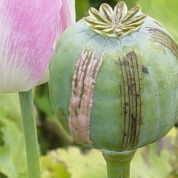Opium

Pharmacology
Opium contains many naturally-occurring chemicals called alkaloids. Alkaloids often possess pharmacological properties and so are widely used as, or as components of drugs –both medically and recreationally.
Opium contains both narcotic alkaloids (such as morphine and codeine) and non-narcotic alkaloids (such as the antispasmodic drug, papaverine). Morphine is the most abundant component of opium.
On entering the body, opium exerts its strong analgesic (painkilling) effect by binding to and activating specific receptors that are ordinarily the binding sites for endorphins (‘feel-good’ chemicals produced by the body itself). These receptors (called mu opioid receptors), are present in the central nervous system (the brain and spinal cord), the stomach and intestines.
Repeated opium use can lead to the formation of more mu opioid receptors in the brain which differ to the original ones in that they will only bind with opium and not the body’s own endorphins. When opium is not used, these new receptors remain unoccupied, reducing the body’s response to endorphins. This can often leave the user feeling worse than they did prior to using opium and may cause physical dependence/ tolerance, resulting in further use in an attempt to return to their original state/ experience the effects of opium as they were when it was first taken.
